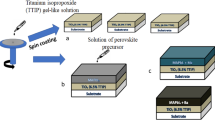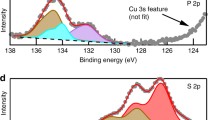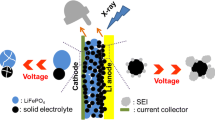Abstract
Organic anode materials have attracted considerable interest owing to their high tunability by adopting various active functional groups. However, the interaction mechanisms between the alkali metals and the active functional groups in host materials have been rarely studied systematically. Here, a widely used organic semiconductor of perylene-3,4,9,10-tetracarboxylic diimide (PTCDI) was selected as a model system to investigate how alkali metals interact with imide functional groups and induce changes in chemical and electronic structures of PTCDI. The interaction at the alkali/PTCDI interface was probed by in-situ X-ray photoelectron spectroscopy (XPS), ultraviolet photoelectron spectroscopy (UPS), synchrotron-based near edge X-ray absorption fine structure (NEXAFS), and corroborated by density functional theory (DFT) calculations. Our results indicate that the alkali metal replaces the hydrogen atoms in the imide group and interact with the imide nitrogen of PTCDI. Electron transfer induced gap states and downward band-bending like effects are identified on the alkali-deposited PTCDI surface. It was found that Na shows a stronger electron transfer effect than Li. Such a model study of alkali insertion/intercalation in PTCDI gives insights for the exploration of the potential host materials for alkali storage applications.

Similar content being viewed by others
References
Goodenough, J. B. How we made the Li-ion rechargeable battery. Nat. Electron. 2018, 1, 204.
Dunn, B.; Kamath, H.; Tarascon, J. M. Electrical energy storage for the grid: A battery of choices. Science 2011, 334, 928–935.
Goodenough, J. B.; Park, K. S. The Li-ion rechargeable battery: A perspective. J. Am. Chem. Soc. 2013, 135, 1167–1176.
Whittingham, M. S. Ultimate limits to intercalation reactions for lithium batteries. Chem. Rev. 2014, 114, 11414–11443.
Slater, M. D.; Kim, D.; Lee, E.; Johnson, C. S. Sodium-ion batteries. Adv. Funct. Mater. 2013, 23, 947–958.
Luo, W.; Wan, J. Y.; Ozdemir, B.; Bao, W. Z.; Chen, Y. N.; Dai, J. Q.; Lin, H.; Xu, Y.; Gu, F.; Barone, V. et al. Potassium ion batteries with graphitic materials. Nano Lett. 2015, 15, 7671–7677.
Tikekar, M. D.; Choudhury, S.; Tu, Z. Y.; Archer, L. A. Design principles for electrolytes and interfaces for stable lithium-metal batteries. Nat. Energy 2016, 1, 16114.
Lu, Y. Y.; Korf, K.; Kambe, Y.; Tu, Z. Y.; Archer, L. A. Ionic-liquid–nanoparticle hybrid electrolytes: Applications in lithium metal batteries. Angew. Chem., Int. Ed. 2014, 53, 488–492.
Bruce, P. G.; Freunberger, S. A.; Hardwick, L. J.; Tarascon, J. M. Li–O2 and Li–S batteries with high energy storage. Nat. Mater. 2012, 11, 19–29.
Zhao, Q.; Lu, Y.; Chen, J. Advanced organic electrode materials for rechargeable sodium-ion batteries. Adv. Energy Mater. 2017, 7, 1601792.
Lu, Y.; Chen, J. Prospects of organic electrode materials for practical lithium batteries. Nat. Rev. Chem. 2020, 4, 127–142.
Lin, D. C.; Liu, Y. Y.; Cui, Y. Reviving the lithium metal anode for high-energy batteries. Nat. Nanotechnol. 2017, 12, 194–206.
Xu, W.; Wang, J. L.; Ding, F.; Chen, X. L.; Nasybulin, E.; Zhang, Y. H.; Zhang, J. G. Lithium metal anodes for rechargeable batteries. Energy Environ. Sci. 2014, 7, 513–537.
Zhao, Q.; Zhu, Z. Q.; Chen, J. Molecular engineering with organic carbonyl electrode materials for advanced stationary and redox flow rechargeable batteries. Adv. Mater. 2017, 29, 1607007.
Lee, S.; Kwon, G.; Ku, K.; Yoon, K.; Jung, S. K.; Lim, H. D.; Kang, K. Recent progress in organic electrodes for Li and Na rechargeable batteries. Adv. Mater. 2018, 30, 1704682.
Xie, J.; Cheng, X. F.; Cao, X.; He, J. H.; Guo, W.; Li, D. S.; Xu, Z. J.; Huang, Y.; Lu, J. M.; Zhang, Q. C. Nanostructured metal-organic conjugated coordination polymers with ligand tailoring for superior rechargeable energy storage. Small 2019, 15, 1903188.
Shea, J. J.; Luo, C. Organic electrode materials for metal ion batteries. ACS Appl. Mater. Interfaces 2020, 12, 5361–5380.
Armand, M.; Grugeon, S.; Vezin, H.; Laruelle, S.; Ribière, P.; Poizot, P.; Tarascon, J. M. Conjugated dicarboxylate anodes for Li-ion batteries. Nat. Mater. 2009, 8, 120–125.
Wang, C.; Tang, W.; Yao, Z. Y.; Chen, Y. Z.; Pei, J. F.; Fan, C. Using an organic acid as a universal anode for highly efficient Li-ion, Na-ion and K-ion batteries. Org. Electron. 2018, 62, 536–541.
Park, Y.; Shin, D. S.; Woo, S. H.; Choi, N. S.; Shin, K. H.; Oh, S. M.; Lee, K. T.; Hong, S. Y. Sodium terephthalate as an organic anode material for sodium ion batteries. Adv. Mater. 2012, 24, 3562–3567.
Chen, Y. N.; Luo, W.; Carter, M.; Zhou, L. H.; Dai, J. Q.; Fu, K.; Lacey, S.; Li, T.; Wan, J. Y.; Han, X. G. et al. Organic electrode for non-aqueous potassium-ion batteries. Nano Energy 2015, 18, 205–211.
Bai, Y. F.; Fu, W. B.; Chen, W. H.; Chen, Z. C.; Pan, X. J.; Lv, X. X.; Wu, J. C.; Pan, X. B. Perylenetetracarboxylic diimide as a high-rate anode for potassium-ion batteries. J. Mater. Chem. A 2019, 7, 24454–24461.
Wang, C.; Tang, W.; Yao, Z. Y.; Cao, B.; Fan, C. Potassium perylene-tetracarboxylate with two-electron redox behaviors as a highly stable organic anode for K-ion batteries. Chem. Commun. 2019, 55, 1801–1804.
Han, X. Y.; Qing, G Y.; Sun, J. T.; Sun, T. L. How many lithium ions can be inserted onto fused C6 aromatic ring systems? Angew. Chem., Int. Ed. 2012, 51, 5147–5151.
Ng, A. M. C.; Djurišić, A. B.; Tam, K. H.; Cheng, K. W.; Chan, W. K.; Tam, H. L.; Cheah, K. W.; Lu, A. W.; Chan, J.; Rakic, A. D. 3,4,9,10-perylenetetracarboxylicdiimide as an interlayer for ultraviolet organic light emitting diodes. Opt. Commun. 2008, 281, 2498–2503.
Zhao, H. J.; Zhao, Y. B.; Song, Y. X.; Zhou, M.; Lv, W.; Tao, L.; Feng, Y. Z.; Song, B. Y.; Ma, Y.; Zhang, J. Q. et al. Strong optical response and light emission from a monolayer molecular crystal. Nat. Commun. 2019, 10, 5589.
Roh, J.; Lee, J.; Kang, C. M.; Lee, C.; Jung, B. J. Air stability of PTCDI-C13-based n-OFETs on polymer interfacial layers. Phys. Status Solidi 2013, 7, 469–472.
Rost, C.; Gundlach, D. J.; Karg, S.; Rieß, W. Ambipolar organic field-effect transistor based on an organic heterostructure. J. Appl. Phys. 2004, 95, 5782–5787.
Deng, W. W.; Shen, Y. F.; Qian, J. F.; Cao, Y. L.; Yang, H. X. A perylene diimide crystal with high capacity and stable cyclability for Na-ion batteries. ACS Appl. Mater. Interfaces 2015, 7, 21095–21099.
Wu, D. Q.; Jing, F.; Xi, X.; Ma, L.; Lu, D.; Yang, P.; Liu, R. L. An acid-pasting approach towards perylenetetracarboxylic diimide based lithium/sodium ion battery cathodes with high rate performances. J. Colloid Interface Sci. 2019, 538, 597–604.
Zhu, X. M.; Liu, X. L.; Deng, W. W.; Xiao, L. F.; Yang, H. X.; Cao, Y. L. Perylenediimide dyes as a cheap and sustainable cathode for lithium ion batteries. Mater. Lett. 2016, 175, 191–194.
Lian, X.; Ma, Z. R.; Zhang, Z. H.; Yang, J. L.; Liu, Y.; Gu, C. D.; Guo, R.; Wang, Y. N.; Ye, X.; Sun, S. et al. Alkali metal storage mechanism in organic semiconductor of perylene-3,4,9,10-tetracarboxylicdianhydride. Appl. Surf. Sci. 2020, 524, 146396.
Frisch, M. J.; Trucks, G. W.; Schlegel, H. B.; Scuseria, G. E.; Robb, M. A.; Cheeseman, J. R.; Scalmani, G.; Barone, V.; Petersson, G. A.; Nakatsuji, H. et al. Gaussian 09, Revision D.01; Gaussian, Inc.: Wallingford, 2009.
Lu, T.; Chen, F. W. Multiwfn: A multifunctional wavefunction analyzer. J. Comput. Chem. 2012, 33, 580–592.
Humphrey, W.; Dalke, A.; Schulten, K. VMD: Visual molecular dynamics. J. Mol. Graph. 1996, 14, 33–38.
Franco-Cañellas, A.; Wang, Q.; Broch, K.; Duncan, D. A.; Thakur, P. K.; Liu, L. J.; Kera, S.; Gerlach, A.; Duhm, S.; Schreiber, F. Metal-organic interface functionalization via acceptor end groups: PTCDI on coinage metals. Phys. Rev. Mater. 2017, 1, 013001.
Peyrot, D.; Silly, F. Temperature-dependent structure of two-dimensional hybrid NaCl-PTCDI nanoarchitectures on Au(111). J. Phys. Chem. C 2017, 121, 20986–20993.
Mura, M.; Silly, F.; Briggs, G. A. D.; Castell, M. R.; Kantorovich, L. N. H-bonding supramolecular assemblies of PTCDI molecules on the Au(111) surface. J. Phys. Chem. C 2009, 113, 21840–21848.
Shi, Y.; Tang, H. M.; Jiang, S. L.; Kayser, L. V.; Li, M. Q.; Liu, F.; Ji, F.; Lipomi, D. J.; Ong, S. P.; Chen, Z. Understanding the electrochemical properties of naphthalene diimide: Implication for stable and highrate lithium-ion battery electrodes. Chem. Mater. 2018, 30, 3508–3517.
Zahn, D. R. T.; Gavrila, G. N.; Salvan, G. Electronic and vibrational spectroscopies applied to organic/inorganic interfaces. Chem. Rev. 2007, 107, 1161–1232.
Taborski, J.; Väterlein, P.; Dietz, H.; Zimmermann, U.; Umbach, E. NEXAFS investigations on ordered adsorbate layers of large aromatic molecules. J. Electron Spectrosc. Relat. Phenom. 1995, 75, 129–147.
Emanuelsson, C.; Johansson, L. S. O.; Zhang, H. M. Photoelectron spectroscopy studies of PTCDI on Ag/Si(111)-\(\sqrt 3 \times \sqrt 3 \). J. Chem. Phys. 2018, 149, 044702.
Acknowledgements
The authors acknowledge the financial support from Singapore MOE Tier II grant R143-000-A29-112, Academic Research Fund Tie I grant RG104/18, and the National Research Foundation under the grant of NRF2017NRF-NSFC001-007, as well as the computing resources from National Supercomputing Centre Singapore.
Author information
Authors and Affiliations
Corresponding authors
Electronic Supplementary Material
Rights and permissions
About this article
Cite this article
Lian, X., Ma, Z., Zhang, Z. et al. An in-situ spectroscopy investigation of alkali metal interaction mechanism with the imide functional group. Nano Res. 13, 3224–3229 (2020). https://doi.org/10.1007/s12274-020-2991-6
Received:
Revised:
Accepted:
Published:
Issue Date:
DOI: https://doi.org/10.1007/s12274-020-2991-6




